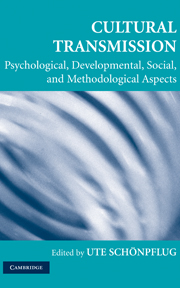Book contents
- Frontmatter
- Contents
- Foreword
- Contributors
- 1 Introduction to Cultural Transmission: Psychological, Developmental, Social, and Methodological Aspects
- 2 Theory and Research in Cultural Transmission: A Short History
- PART ONE EVOLUTIONARY PERSPECTIVE
- PART TWO CROSS-CULTURAL PERSPECTIVE
- 6 An Ecocultural Perspective on Cultural Transmission: The Family across Cultures
- 7 Intergenerational Relations and Cultural Transmission
- 8 Intergenerational Transmission, Social Capital, and Interethnic Contact in Immigrant Families
- 9 Developmental Processes Related to Intergenerational Transmission of Culture: Growing Up with Two Cultures
- 10 The Transmission Process: Mechanisms and Contexts
- 11 Accounting for Parent–Child Value Congruence: Theoretical Considerations and Empirical Evidence
- 12 Culture, Migration, and Family-Value Socialization: A Theoretical Model and Empirical Investigation with Russian-Immigrant Youth in Israel
- 13 Immigrant Parents' Age Expectations for the Development of Their Adolescent Offspring: Transmission Effects and Changes after Immigration
- PART THREE INTRACULTURAL VARIATIONS
- Index
- References
7 - Intergenerational Relations and Cultural Transmission
Published online by Cambridge University Press: 05 June 2012
- Frontmatter
- Contents
- Foreword
- Contributors
- 1 Introduction to Cultural Transmission: Psychological, Developmental, Social, and Methodological Aspects
- 2 Theory and Research in Cultural Transmission: A Short History
- PART ONE EVOLUTIONARY PERSPECTIVE
- PART TWO CROSS-CULTURAL PERSPECTIVE
- 6 An Ecocultural Perspective on Cultural Transmission: The Family across Cultures
- 7 Intergenerational Relations and Cultural Transmission
- 8 Intergenerational Transmission, Social Capital, and Interethnic Contact in Immigrant Families
- 9 Developmental Processes Related to Intergenerational Transmission of Culture: Growing Up with Two Cultures
- 10 The Transmission Process: Mechanisms and Contexts
- 11 Accounting for Parent–Child Value Congruence: Theoretical Considerations and Empirical Evidence
- 12 Culture, Migration, and Family-Value Socialization: A Theoretical Model and Empirical Investigation with Russian-Immigrant Youth in Israel
- 13 Immigrant Parents' Age Expectations for the Development of Their Adolescent Offspring: Transmission Effects and Changes after Immigration
- PART THREE INTRACULTURAL VARIATIONS
- Index
- References
Summary
INTRODUCTION
Continuity and change of cultures over generations are affected by cultural transmission. The intergenerational transmission of culture refers to the way values, knowledge, and practices that are prevalent in one generation are transferred to the next generation. Cultural transmission, thus, is seen as a process by which the reproduction of culture occurs in each successive generation (Corsaro, 1997). However, the persistent reproduction of culture is only one aspect of (absolute) cultural transmission; another aspect is selective transmission. Transmission can be more or less intended and planned; it can also be a direct or indirect consequence of certain activities and events. Furthermore, the direction of transmission and its process can vary. Cavalli-Sforza and Feldman (1981) originally drew a distinction between horizontal (i.e., within one generation) and oblique (i.e., between generations) transmission; in other studies, horizontal transmission includes both (Hewlett & Cavalli-Sforza, 1986). In line with research on socialization, more recent studies differentiate between three types of transmission: vertical transmission between parents and their offspring, oblique transmission functioning through socialization institutions and other agents (e.g., parents' peers), and horizontal transmission among peers (Berry, Poortinga, Segall, & Dasen, 2002).
Intergenerational transmission has been seen as based on the relationship between different cohorts who share the same historical and socialization background but who are not biologically related (cf. Mannheim, 1929/1964). The focus of psychologists is on individuals who belong to the same family interacting with each other in the process of intergenerational transmission.
- Type
- Chapter
- Information
- Cultural TransmissionPsychological, Developmental, Social, and Methodological Aspects, pp. 126 - 160Publisher: Cambridge University PressPrint publication year: 2008
References
- 15
- Cited by



